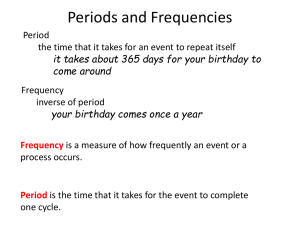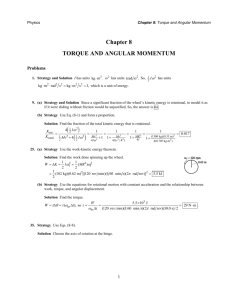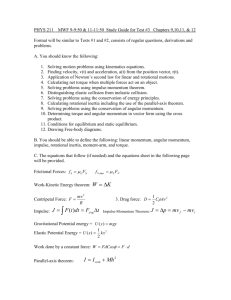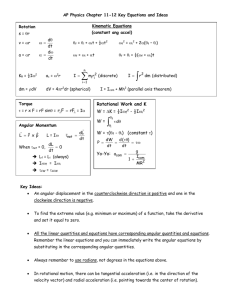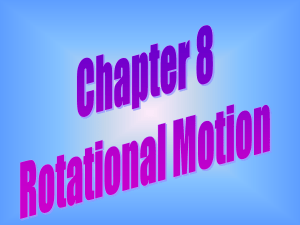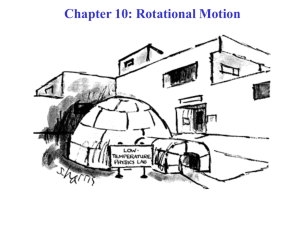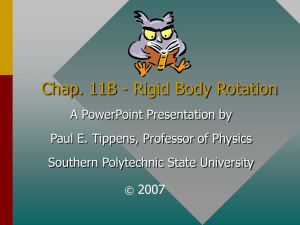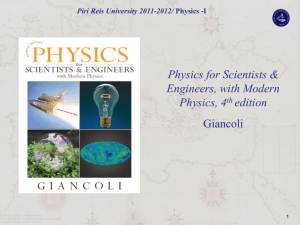ROTATIONAL MOTION
advertisement
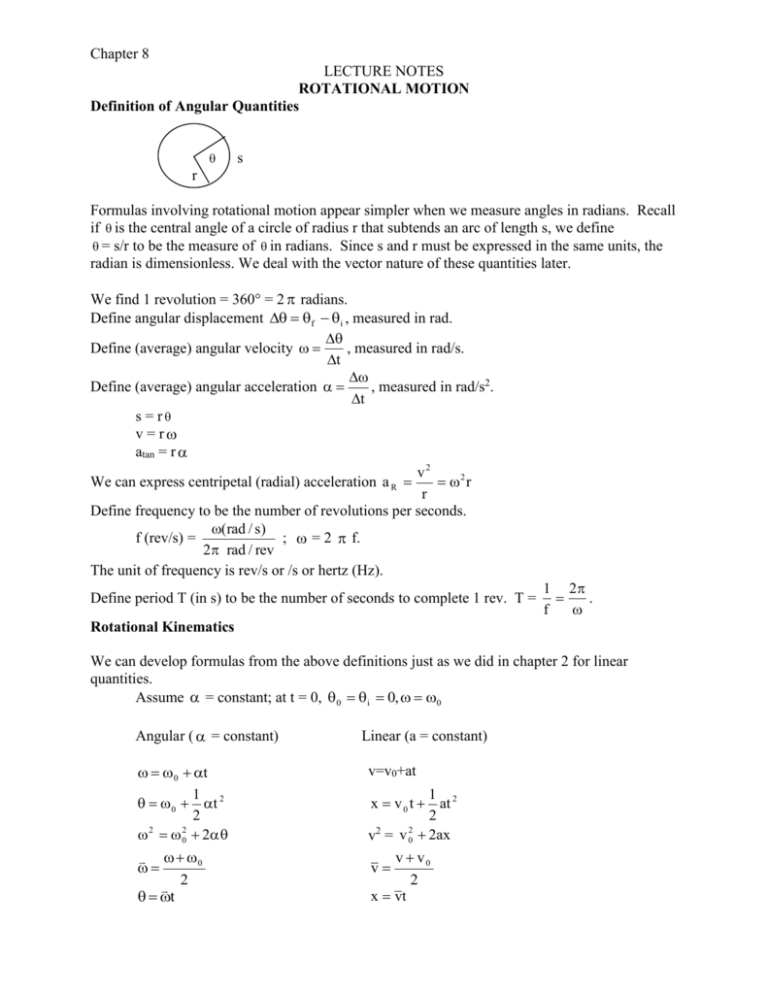
Chapter 8 LECTURE NOTES ROTATIONAL MOTION Definition of Angular Quantities s r Formulas involving rotational motion appear simpler when we measure angles in radians. Recall if is the central angle of a circle of radius r that subtends an arc of length s, we define = s/r to be the measure of in radians. Since s and r must be expressed in the same units, the radian is dimensionless. We deal with the vector nature of these quantities later. We find 1 revolution = 360 = 2 radians. Define angular displacement f i , measured in rad. Define (average) angular velocity , measured in rad/s. t Define (average) angular acceleration , measured in rad/s2. t s = r v = r atan = r v2 We can express centripetal (radial) acceleration a R 2 r r Define frequency to be the number of revolutions per seconds. (rad / s) f (rev/s) = ; = 2 f. 2 rad / rev The unit of frequency is rev/s or /s or hertz (Hz). Define period T (in s) to be the number of seconds to complete 1 rev. T = 1 2 . f Rotational Kinematics We can develop formulas from the above definitions just as we did in chapter 2 for linear quantities. Assume = constant; at t = 0, 0 i 0, 0 Angular ( = constant) 0 t 1 0 t 2 2 2 2 0 2 0 2 t Linear (a = constant) v=v0+at 1 x v 0 t at 2 2 2 2 v = v 0 2ax v v0 2 x vt v Chapter 8 LECTURE NOTES Rotational Dynamics Just as forces provide a cause for liner motion, torques produce rotational motion. A torque is a "twist" and is defined as the vector cross product of a radius vector (from the axis of rotation to the point of application of the force) and a force; r xF rF sin ; units N • m. r The direction of the torque vector is defined by the right hand rule (here into the page) or by the rotation it tends to impart (here, clockwise). F Note we can interpret rF sin as r(F sin ) rF F r Torque is the product Fsin of the lever arm r and the perpendicular component of force F . Also, torque is the product of a force and the component of r to the line of action of the force. F r sin =r Rotational Analog of Newton's Second Law Consider a ball tethered to a pole at the end of a cord of length r. If we exert a force F on the ball it accelerates. F = ma = mr . Multiply by r to find Fr = mr2 or I . Here I = mr 2 is the rotational inertia or moment of inertia for a point mass rotating about an axis r distant. I is measured in units of kg m2 and may be derived (with calculus) for a variety of rotating objects (see table in text). Example: A cord wrapped around a disk 0.100m in radius is pulled with a tangential force of 30.0N for 1.00s. If the disk (0.500 kg in mass) is initially at rest, how fast is it spinning at the end of the 1.00s pull? 1 mr 2 = .0025 kg m2 2 = Fr = 3.00 mN 1200 rad/s2 I 0 t =1200 rad/s What is the angular velocity in rpm? What is the linear velocity of a point on the rim of the disk? I disk = Chapter 8 LECTURE NOTES Rotational Kinetic Energy A rotating object has total KE = 1 1 1 1 mv 2 I 2 , both linear ( mv2 ) and rotational ( I 2 ). 2 2 2 2 Example: Find the velocity of a sphere after it rolls from rest without slipping down an incline of vertical height h. Neglect frictional losses. KEi PE i KE f PE f 1 1 0 + mgh = ( mv2 + I 2) + 0 2 2 2 Recall I sphere = mr2 and v = r 5 2 1 12 v 7 mgh = mv 2 mr 2 2 mv 2 2 25 r 10 10gh 7 If the sphere were sliding instead of rolling v = 2gh (faster). In that case, no energy would have gone into rotational motion. Note: There must be some friction or rolling cannot occur. Thus v = In a race between hoops, empty cans, solid cylinders, and spheres of various masses and radii, in what order do these objects reach the bottom of an incline? Assume they roll without slipping. Angular Momentum The quantity L = I (units kg • m 2 /s) is conserved if no net external torque acts on a body. It plays a role analogous to linear momentum. I so t I L t t is angular impulse; it produces a change in angular momentum. If ext 0, I 0 0 I = constant. Various demonstrations will be done illustrating conservation of angular momentum. I Vector Nature of Angular Quantities We have stated has a direction given by the right rule. A similar rule gives the direction of ; curl the fingers of the right hand in the direction an object rotates and the thumb points in the direction of . L points in the same direction as and in the same direction as .


